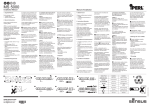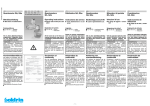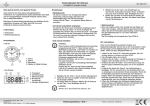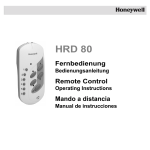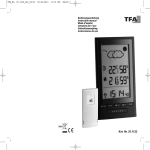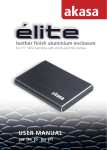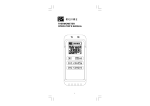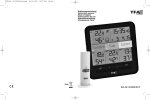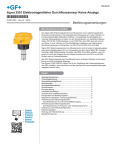Download MD 5000 - Armatec
Transcript
DE FR ES MD 5000 Installation Manual 1. Supplied Material have to be followed, in particular with regard to health and safety (e.g. earthing, bridging, etc.). Composite materials used are nonconductive. Each package contains: • 1 iPERL device • manual • sealings • optional connection kits • NRV (if ordered) Torque: tighten iPERL to a minimum torque setting of 20Nm and a maximum of 30Nm. 2. General Instructions Please read this guide prior to installing iPERL. iPERL is a metering endpoint designed for use with potable water supplies to residential, commercial and industrial activities. iPERL is intended for maintenance-free operation for up to 15 years. IPERL is hermetically sealed and therefore there is no servicing of the meter required. 3. Permissible Operating Conditions • min. water conductivity required: 120µS/cm (25 °C) • Cold water meter: from 0.1 °C up to 50 °C • Pressure stage: PN16 • Mechanical environment: M2 (MID) fixed installation with minimum vibration • Electromagnetic environmental class: E1 and E2 (MID) residential and commercial • Protection class: IP68 • Climatic environment: from -15 °C up to 60 °C 4. Installation Requirements Ensure that the pipework does not introduce mechanical stresses on the meter body: checking both alignment of the pipework with the threaded connections and distance between unions with the meter lay length. If there is mechanical stress usage of the brackets is recommended. When mounting iPERL onto a network, ensure contact surfaces are even and clean and use new gaskets. At all times during installation and thereafter all statutory provisions, regulations and norms 1 ← 1 Installation position: iPERL has been designed to operate, with no impact on metrological performance, in all installation angles and orientations. 2 Please avoid installing iPERL as shown below as a reduction of battery lifetime could occur. Keep the valves closed when the premises are vacant. Make sure you close both valves before and after the meter for safety reasons when installation is not finished yet or there is no water consumption for a longer period, e.g due to vacant premises. iPERL is free of any constraint for upstream or downstream straight pipe lengths. Flow direction: iPERL’s metrological performance is independent of flow direction and orientation of the meter can be selected to best suit the installation conditions. iPERL will detect flow direction when installed and set the direction indicator accordingly. Pressure: please ensure that iPERL strictly operates within the pressure rating printed on the meter body. All iPERL settings and functions will be automatically and correctly activated once the flowtube is saturated. 5. Installation Procedure (Volume registration & Flow direction) STEP1: 1A: Remove iPERL from its packaging and locate any optional component (filter, nonreturn-valve* (NRV), ...) In case you need a non-return-valve please consider: 3 iPERL, DN 15, 110 and 115 mm: NRV installation in meter screw connection 4 All other nominal sizes and lengths: NRV installation in measuring tube iPERL will display the following symbols: 5 No Volume, no flow and the alarm flag (raised for empty pipe) 1B: Install iPERL according to the most suitable LCD orientation STEP2: 6 Once installed, open the upstream valve to fill the meter. The alarm flag disappears after a short while, this indicates that the meter has detected water in the pipe. iPERL is now fully operational, although in stand-by mode. At this point, also the radio transmission is activated which is indicated by a flashing radio symbol. The meter starts to send out radio telegrams. STEP3: 7 To activate the “flow direction detection”, ensure a flow above the threshold of 3 l/h for DN 15 5 l/h for DN 20 8 l/h for DN 25 12.5 l/h for DN 32 20 l/h for DN 40 Both arrows blink to indicate the meter is detecting its forward flow direction. After reaching the threshold the arrow is set. It starts to accumulate volume into the three registers forward, reverse and billing volume. The flowrate will start to be displayed after the first 4 hours of operation. When the billing volume register reaches the threshold of 25l for DN 15 40l for DN 20 63l for DN 25 - 40 the meter takes that register with the higher volume accumulated as the forward register and fixes the flow direction. From this moment on the flow direction cannot be changed; any flow in the 'wrong' direction will now trigger the alarm flag for 'reverse flow' and will be counted as reverse volume. 5 3 iPERL 8 After the flow direction is set, the functions for performing the higher analysis, such as data logging and leak detection, become active and are assigned to the respective data fields. 9 IMPORTANT! iPERL does not register the volume if the averaged flowrate is below 1 l/h for DN 15 1.6 l/h for DN 20 2.5 l/h for DN 25 4 l/h for DN 32 6.4 l/h for DN 40 6. iPERL Display and Characters 10 After installation is successfully completed the display shows: • Meter reading and preselected unit • Current flowrate and preselected unit • Flow direction • RF active Alarms are displayed directly on the display after the LCD self-test: AL – 05 Empty pipe AL – 06 Magnetic tampering AL – 07 Reverse Flow AL – 08 Broken pipe / Leakage If any of the following graphics is displayed, please contact your supplier: • Alarm flag + AL-xx (except 05-08, see above) • Low battery warning • Test mode 7. Disposal 11 This product contains a lithium Ion battery. In the interest of protecting the environment, this battery may not be disposed in household waste after its period of use. The local and national regulations for environmental protection are to be considered. 8 *Australia only: NRV is already pre-installed! EN Graphic Description 11 Meter Reading Current flowrate ← 2 8 www.sensus.com [email protected] 6 9 Alarm flag 4 Flow direction RF active ← 7 10 Low battery warning Test mode 1241 Lithium 5 MD 5000 INT4 • 0003 Index units Flowrate units DE FR ES MD 5000 Einbau- und Betriebsanweisung 1. Lieferumfang Jede Verpackungseinheit enthält: • 1 iPERL • Bedienungsanleitung • Dichtungen • Optionalen Anschluss-Satz (sofern entsprechend bestellt) • Rückflussverhinderer (sofern bestellt) 2. Allgemeine Hinweise Bevor Sie iPERL installieren, lesen Sie bitte diese Einbau- und Betriebsanweisung und gehen Sie wie beschrieben vor. iPERL ist ein Endpunkt zur Messung von Trinkwasser in Wohngebäuden sowie im gewerblichen und industriellen Bereich. iPERL ist für einen wartungsfreien Betrieb von bis zu 15 Jahren bestimmt. Nationale Einbaufristen sind jedoch zu beachten. Da iPERL hermetisch abgedichtet ist, entsteht kein Wartungsaufwand. 3. Zulässige Betriebsbedingungen • Mindest-Leitfähigkeit des Wasser: 120µS/cm (25 °C) • Kaltwasser: von + 0,1 bis zu + 50 °C • Druckstufe: PN 16 • Mechanische Umgebungsklasse nach MID: M2 = unbedeutende Schwingungen und Erschütterungen • Elektromagnetische Umgebungsklasse nach MID: E1 und E2 = für Wohn-, Gewerbe- und Industrieanlagen • Schutzklasse: IP68 • Umgebungstemperatur: von - 15 bis zu + 60 °C 4. Installationsvoraussetzungen Stellen Sie sicher, dass die Rohrleitungen keine mechanischen Kräfte (Zug, Druck, etc.) auf das Gerät ausüben: Überprüfen Sie sowohl die lineare Ausrichtung der Rohrleitungen mit den Schraubverbindungen, als auch den Abstand entsprechend der Baulänge des iPERL. Bei mechanischer Belastung empfiehlt es sich, einen Montagebügel zu verwenden. Bei der Montage des iPERL in ein Rohrnetz müssen alle Dichtflächen eben und sauber sein, sowie mit neuen Dichtungen ausgestattet werden. 1 ← Während und nach der Installation sind alle gesetzlichen Bestimmungen, Vorschriften und Normen zu beachten, insbesondere im Hinblick auf Arbeitssicherheit (z. B. Erdung, Erdungsbrücken, etc.). Die verwendeten Verbundmaterialien sind nichtleitend. Drehmoment: Die Verschraubung des iPERL ist mit einem Drehmoment von min. 20 Nm und max. 30 Nm anzuziehen 1 Einbaulage: Beliebig; iPERL garantiert volle messtechnische Leistungsfähigkeit unabhängig von der Einbaulage 2 Bitte vermeiden Sie die unten aufgeführte Einbaulage, da sonst die Lebensdauer der Batterie negativ beeinträchtigt wird. Halten Sie die Ventile geschlossen, wenn die Räumlichkeiten leer stehen. Stellen Sie aus Sicherheitsgründen sicher, das beide Ventile vor und nach dem Zähler geschlossen sind, wenn die Installation noch nicht abgeschlossen ist oder es für eine längere Zeit keinen Wasserverbrauch gibt, z.B. bei leerstehenden Gebäuden. iPERL benötigt keinerlei geraden Ein- bzw. Auslaufstrecken Durchflussrichtung: Die Fließrichtung hat keinen Einfluss auf die metrologische Genauigkeit des iPERL. Er kann in jeder gewünschten Position installiert werden. iPERL erkennt nach der Installation automatisch die Fließrichtung und zeigt dies entsprechend auf dem Display an. Druckstufe: Stellen Sie sicher, dass der maximale Druck der Druckstufe des iPERL entspricht. Die Druckstufe finden Sie auf dem Gehäuse des iPERL. Sobald das Messrohr mit Wasser befüllt ist, werden alle Einstellungen und Funktionen von iPERL automatisch erkannt und den Anforderungen entsprechend korrekt aktiviert. 5. Installation (Durchflusserkennung & Fließrichtung) SCHRITT1: 1A: Entnehmen Sie iPERL aus der Verpackung und installieren Sie ggf. zusätzliche Komponenten (Filter, Rückschlagventil*, etc.) Wenn Sie einen Rückflussverhinderer benötigen, beachten Sie bitte Folgendes: 3 Bei iPERL DN 15, Baulänge 110 mm und 115 mm wird der Rückflussverhinderer in die Zählerverschraubung montiert 4 Bei allen anderen Nenngrößen und Baulängen wird der Rückflussverhinderer in das Messrohr montiert Folgende Symbole werden angezeigt: 5 Kein Volumen, kein Durchfluss und Alarmflagge (bei leerer Rohrleitung). 1B: Installieren Sie iPERL entsprechend der besten Ablesbarkeit des Displays. SCHRITT 2: 6 Nach der Installation öffnen Sie das Zulaufventil, bis die Alarmflagge auf dem Display erlischt und damit anzeigt, dass sich Wasser im Messrohr befindet. iPERL ist nun voll funktionsfähig, befindet sich jedoch noch im Stand-by Modus. Zu diesem Zeitpunkt wird auch die Funkübertragung aktiviert, was durch ein blinkendes Funksymbol auf dem Display angezeigt wird. Das Gerät startet mit der Übetragung der Funktelegramme. SCHRITT 3: 7 Um die „Fließrichtungserkennung“ zu aktivieren, muss das Gerät einen Durchfluss von min. 3 l/h bei DN 15 5 l/h bei DN 20 8 l/h bei DN 25 12,5 l/h bei DN 32 20 l/h bei DN 40 erfahren. Der tatsächliche Durchfluss wird auf dem Display angezeigt, nachdem das Gerät 4 Stunden in Betrieb war. Beide Pfeile blinken, um anzuzeigen, dass der Zähler seine Vorwärtsflussrichtung erkennt. Nach Erreichen des Schwellwerts wird der Pfeil festgelegt. Das Gerät speichert das Volumen in drei verschiedenen Registern: Vorwärts- , Rückwärts- und Verbrauchsvolumen. Sobald das Verbrauchsvolumen den Schwellwert von 25l bei DN 15 40l bei DN 20 63l bei DN 25 - 40 5 3 iPERL erreicht hat, wird das Register mit dem höheren Volumen als Vorwärtsregister definiert und die Fließrichtung fixiert. Ab diesem Moment ist die Fließrichtung festgelegt und kann nicht mehr geändert werden. Jeder Durchfluss in der „falschen“ Richtung löst nun die Alarmflagge aus und wird als Rückwärtsvolumen erfasst. 8 Nachdem die Fließrichtung eingestellt ist, sind alle Funktionen für die Messdaten-Analyse aktiv, wie etwa Datenprotokollierung (Logging) oder Leckagenerkennung. Diese sind ab sofort den jeweiligen Datenfeldern zugewiesen. 9 Wichtig: iPERL zählt keine Durchflussmenge, solange der gemittelte Durchfluss unterhalb von 1 l/h bei DN 15 1,6 l/h bei DN 20 2,5 l/h bei DN 25 4 l/h bei DN 32 6,4 l/h bei DN 40 ist. 6. iPERL Display und Symbole 10 Nach vollständiger Installation des iPERL zeigt das Display folgenden Inhalt an: • Verbrauchsvolumen und entsprechende Einheit • Aktueller Durchfluss und entsprechende Einheit • Durchflussrichtung • Funkübertragung aktiviert Folgende Alarme werden unmittelbar nach dem LCD-Selbsttest auf dem Display angezeigt: AL – 05 leere Rohrleitung AL – 06 Magnetische Beeinflussung AL – 07 Rückwärtsfluss AL – 08 Rohrbruch / Leckage Falls eines der folgenden Symbole angezeigt wird, wenden Sie sich bitte an Ihren Lieferanten: • Alarmflagge + AL-xx (außer 05-08, s. oben) • Warnung für schwache Batterie • Test-Modus 7. Entsorgung 11 Dieses Gerät enthält eine Lithium-batterie. Im Interesse des Umweltschutzes darf diese Batterie nicht mit dem normalen Haushaltsmüll entsorgt werden. Die jeweiligen nationalen Umweltvorschriften sind zu beachten. 8 * nur für Australien: Rückschlagventil ist bereits vormontiert! EN Graphic Description 11 Meter Reading Current flowrate ← 2 8 www.sensus.com [email protected] 6 9 Alarm flag 4 Flow direction RF active ← 7 10 Low battery warning Test mode 1241 Lithium 5 MD 5000 INT4 • 0003 Index units Flowrate units DE FR ES MD 5000 Manuel d’Installation 1. Matériel fourni Chaque conditionnement contient : • 1 iPERL • Manuel • Joints • 1 ensemble d’accessoires de montage • Clapet anti-retour (si commandé) 2. Instructions générales Veuillez lire ce guide attentivement avant d’installer iPERL. iPERL est un compteur pour réseau d’eau potable à destination des logements et des activités commerciales et industrielles. iPERL est destiné à fonctionner sans entretien pour une durée de 15 ans. iPERL est donc entièrement scellé et ne nécessite aucune maintenance. 3. Conditions de fonctionnement • conductivité de l'eau minimum requise : 120µS/cm (25 °C) • Compteur eau froide : de +0,1 °C à +50 °C • Pression maximale admissible : PN16 • Environnement mécanique : M2 (installations fixes avec vibrations faibles) • Environnement électromagnétique : E1 (résidentiel) et E2 (commercial et industrie légère) • Indice de Protection : IP68 • Environnement climatique : de -15 °C à +60 °C. 4. Conditions d'installation Assurez-vous que la conduite ne crée pas de contrainte mécanique sur le corps du compteur en vérifiant l’alignement entre la canalisation et le compteur ainsi que la distance entre les raccords et la longueur du corps. En cas de tension mécanique, l’utilisation d’un support est recommandée. 1 ← Au montage d’iPERL sur le réseau, vérifiez que les filetages soient lisses et propres et utilisez des joints neufs. A chaque étape de l’installation, l’ensemble des dispositions suivantes, les règlements et les normes en vigueur doivent être suivis, particulièrement en ce qui concerne la santé et la sécurité (ex : mise à la terre, raccordement, ...). Les matériaux composites utilisés sont non-conducteurs. Serrage : serrez les écrous de raccords iPERL avec un couple de serrage compris entre 20 Nm et 30 Nm. 1 Positions d’installation : iPERL a été conçu pour fonctionner, sans impacter ni sa précision ni sa métrologie, dans toutes les positions et orientations. Evitez cependant de le monter dans la position 2 ci-dessous afin de ne pas affecter la durée de vie de la batterie. Gardez les vannes fermées quand les locaux sont inutilisés. Veillez à fermer les vannes amont et aval au compteur pour des raisons de sécurité quand l’installation n’est pas terminée ou qu’il n’y a pas de consommation d’eau pendant une grande période, locaux inoccupés par exemple. iPERL ne nécessite pas de longueurs droites ni en aval ni en amont (U0 / D0 selon MID). Sens d’écoulement : la précision d’iPERL est absolument indépendante du sens d'écoulement de l’eau. Son installation peut donc se faire simplement en tenant compte des conditions de pose. iPERL détecte automatiquement le sens d’écoulement et l’affiche instantanément sur son écran LCD. Pression : assurez-vous qu’iPERL opère strictement dans la limite de pression indiquée sur le corps du compteur. Tous les paramètres et fonctions d’iPERL sont automatiquement activés une fois le tube d’écoulement plein. 5. Procédure d’Installation (Enregistrement du Volume & Sens d’Ecoulement) ETAPE 1 : 1A : retirez iPERL de son emballage en prenant soin de mettre de côté tous les accessoires livrés avec (filtre, clapet*…) Dans le cas où vous avez besoin d’un clapet : 3 IPERL DN15, 110 et 115 mm : installation du clapet en appui dans la tubulure 4 Toutes les autres tailles et dimensions : clapet insér dans le tube de mesure 5 Pas de volume, pas de débit et drapeau d’alarme activé (activé car conduite vide) 1B : Installez iPERL selon la position la plus adaptée pour faciliter sa lecture. ETAPE 2 : 6 Une fois installé, ouvrez la vanne amont afin de remplir le compteur. Le drapeau d’alarme doit disparaître après un court instant, cela indique qu'iPERL a détecté la présence d’eau dans la conduite. iPERL est maintenant opérationnel, et les émissions radio sont dorénavant activées. Ceci est matérialisé par un symbole radio clignotant. Le compteur commence à émettre. ETAPE 3 : 7 Pour que le “sens d’écoulement” soit activé, veuillez-vous assurer que vous avez atteint les seuils de débit suivants : 3 l/h pour DN 15 5 l/h pour DN 20 8 l/h pour DN 25 12,5 l/h pour DN 32 20 l/h pour DN 40 Le débit réel sera affiché à l’écran après 4 heures de fonctionnement. Les 2 flèches clignotent pour indiquer que le compteur détecte son sens d’écoulement. Une fois que le seuil de volume mini est atteint, la flèche indiquant le sens d’écoulement est figée. iPERL commence alors à comptabiliser les volumes Aller et Retour séparément. Lorsque l’index volume atteint les valeurs de seuils suivants : 25l pour DN 15 40l pour DN 20 63l pour DN 25 - 40 Dès lors, le sens d’écoulement ne pourra 5 3 iPERL être modifié ; tous les débits contraires déclencheront désormais l’alarme “Retour d’eau” et seront comptés comme un volume retour. 8 Une fois que le sens d’écoulement du compteur est figé, les fonctions d’analyse (comme la détection de fuite, ou la sauvegarde des données) sont activées. 9 IMPORTANT! iPERL ne comptabilise pas de volume pour les débits moyens inférieurs à : 1 l/h pour DN 15 1,6 l/h pour DN 20 2,5 l/h pour DN 25 4 l/h pour DN 32 6,4 l/h pour DN 40 6. Indications présentes à l’affichage 10 Après installation, l’affichage indique : •Index et son unité •Débit instantané et son unité •Sens d’écoulement du flux •Emissions radio activées Les alarmes sont affichées directement sur l’écran, juste après le test d’affichage comme suit : AL – 05 Conduite vide AL – 06 Fraude magnétique AL – 07 Retour d’eau AL – 08 Rupture canalisation/Fuite Si l’un de ces symboles est affiché, veuillez contacter votre fournisseur : •Alarme + AL-xx (sauf 05 et 08, voir ci- dessus) •Alerte batterie faible •Mode Test 7. Recyclage 11 Ce produit contient une pile Ion-Lithium. En vue de la protection de l’environnement, cette pile ne doit pas être jetée à la poubelle en fin de vie. Vous devez respecter les conditions de recyclage des produits selon les réglementations en vigueur dans le pays concerné. 8 *Pour l’Australie uniquement : le clapet anti retour est préinstallé lors de la livraison EN Graphic Description 11 Index du compteur Débit instantané ← 2 8 www.sensus.com [email protected] 6 9 Drapeau d'alarme 4 Sens d'écoulement RF activée ← 7 10 Alerte batterie faible Mode test 1241 Lithium 5 MD 5000 INT4 • 0003 Unités d'index Unités de débit DE FR ES MD 5000 Manual de Instalación 1. Material Suministrado Par: aplicar en iPERL un mínimo par de rosca de 20 Nm y un máximo de 30 Nm. Cada caja contiene: • 1 dispositivo iPERL • manual • juntas • kits de conexión opcionales • válvula anti-retorno (si solicitada) 1 Posición de instalación: iPERL se ha diseñado para funcionar en todas las posiciones sin ningún impacto en su comportamiento metrológico. Lea atentamente esta guía antes de instalar iPERL. 2 Por favor evite instalar iPERL como se muestra en la figura inferior ya que podría producir una reducción de la vida útil de la batería. iPERL es un sensor de medida diseñado para su uso en el suministro de agua potable residencial, comercial e industrial. iPERL está diseñado para un funcionamiento libre de mantenimiento de hasta 15 años. IPERL está herméticamente sellado y por lo tanto no requiere ningún tipo de mantenimiento. Asegúrese de cerrar la válvula anterior y posterior al sensor de medida por razones de seguridad cuando la instalación no esté finalizada todavía o en caso de que no tenga que existir consumo de agua por un periodo de tiempo prolongado (por ej. en el caso de un piso desocupado). 3. Condiciones de Funcionamiento iPERL no tiene ninguna restricción en cuanto a tramo recto aguas arriba y aguas abajo. 2. Instrucciones Generales • Conductividad mínima del agua requerida: 120 µS/cm (25 °C) • Medidor de agua fría: de 0,1 °C hasta 50 °C • Presión admisible: PN16 • Clase mecánica: M2 (MID) instalación fija con mínima vibración • Clase electromagnética: E1 y E2 (MID) residencial y comercial • Protección: IP68 • Entorno climático: desde -15 °C hasta 60 °C 4. Requisitos de instalación Asegurar que la tubería no produce estrés mecánico en el cuerpo del medidor: comprobar la alineación de la tubería con las roscas de conexión y la longitud del tramo de conexión con la longitud del medidor. Si existe estrés mecánico, el uso de abrazaderas es recomendable. Cuando se instale iPERL en la tubería, asegurar que las superficies de contacto están limpias, niveladas y que las juntas utilizadas son nuevas. En toda instalación se debe cumplir la normativa vigente en materia de seguridad laboral y medioambiental (aislamiento eléctrico, etc..). El material composite utilizado no es conductor. 1 ← Dirección de flujo: el comportamiento metrológico de iPERL es independiente de la dirección de flujo y puede escoger la mejor posición acorde a las condiciones de instalación. iPERL detectará la dirección de flujo una vez instalado y fijará la dirección de medición acordemente. Presión: por favor asegúrese que iPERL opera estrictamente dentro del ratio de presión indicado en el cuerpo del medidor. Todas las configuraciones y funciones de iPERL se activaran automáticamente una vez la tubería esté llena (ver 5). 5. Procedimiento de instalación (registro de volumen & dirección de Flujo) PASO 1: 1A: Extraiga iPERL de su embalaje y ensamble cualquier componente opcional (filtro, válvula anti-retorno*, ...). En el caso que se necesite una válvula antiretorno, considere lo siguiente: 3 iPERL, DN 15, 110 y 115 mm: instalación en la conexión roscada del sensor de medida 4 Otros tamaños y longitudes: válvula antiretorno instalada en el tubo de medida 5 Sin volumen, sin caudal y aviso de alarma (activado por tubería vacía) 1B: Instalar iPERL según la orientación más adecuada para la pantalla LCD PASO 2: 6 Una vez instalado, abrir la válvula aguas arriba para llenar el sensor de medida. El aviso de alarma desaparece después de un corto espacio de tiempo, lo que indica que el equipo ha detectado agua en la tubería. Ahora IPERL está completamente operativo, aunque en modo stand-by. En este momento, también se activa la transmisión radio indicada mediante un símbolo radio intermitente. El sensor de medida empieza a enviar telegramas radio. PASO 3: 7 Para activar la “detección de dirección de flujo”, asegure un caudal por encima de los siguientes niveles 3 l/h para DN 15 5 l/h para DN 20 8 l/h para DN 25 12,5 l/h para DN 32 20 l/h para DN 40 El caudal instantaneo será mostrado en pantalla tras 4 horas de operación. Ambas flechas parpadean para indicar que el sensor de medida está detectando su dirección de flujo hacia adelante. Una vez alcanzado el nivel, la flecha queda fijada. Se empieza a acumular volumen en los tres registros de volumen hacia adelante, hacia atrás y de facturación. Cuando el registro de volumen de facturación alcanza los siguientes límites 25 l para DN 15 40 l para DN 20 63 l para DN 25 - 40 el sensor de medida toma ese registro con el volumen acumulado más alto como el registro de volumen hacia adelante y fija la dirección de flujo. Desde este momento, la dirección del flujo no puede cambiarse; cualquier caudal en la dirección contraria activará la alarma de caudal de retorno y será contabilizada como volumen en sentido contrario 5 3 iPERL 8 Una vez la dirección de flujo se fija, las funciones para realizar análisis más detallados, como el registrador de datos y la detección de fuga, se activan y son asignadas a sus respectivos campos de datos. 9 ¡IMPORTANTE! iPERL no registra volumen si el caudal medio es inferior a 1 l/h para DN 15 1,6 l/h para DN 20 2,5 l/h para DN 25 4 l/h para DN 32 6,4 l/h para DN 40 6. Pantalla y características de iPERL 10 Después de la correcta y completa instalación, la pantalla muestra: • lectura del sensor de medida y unidades pre-seleccionadas • caudal actual y unidades pre-seleccionadas • Dirección del flujo • Radio activa Las alarmas se muestran directamente en la pantalla después del auto-chequeo del LCD: AL – 05 Tubería vacía AL – 06 Manipulación magnética AL – 07 Flujo reverso AL – 08 Tubería rota / Fuga Si alguno de los siguientes símbolos se muestra, contacte con su proveedor: • Aviso de alarma + AL-xx (excepto 05-08, ver arriba) • Aviso de batería baja • Modo de ensayo 7. Eliminación de residuos 11 Este producto contiene una batería de ión litio. Con el interés de proteger el medioambiente, esta batería no puede ser depositada en la basura urbana una vez utilizada. Las regulaciones locales y nacionales para la protección del medio ambiente tienen que ser consideradas. 8 *sólo para Australia: válvula anti-retorno ya instalada EN Símbolo Descripción 11 Índice del medidor caudal instantáneo ← 2 8 www.sensus.com [email protected] 6 9 Unidades del caudal Alarma 4 Dirección del flujo RF activa ← 7 10 Aviso de batería baja Modo ensayo 1241 Lithium 5 MD 5000 INT4 • 0003 Unidades del índice




